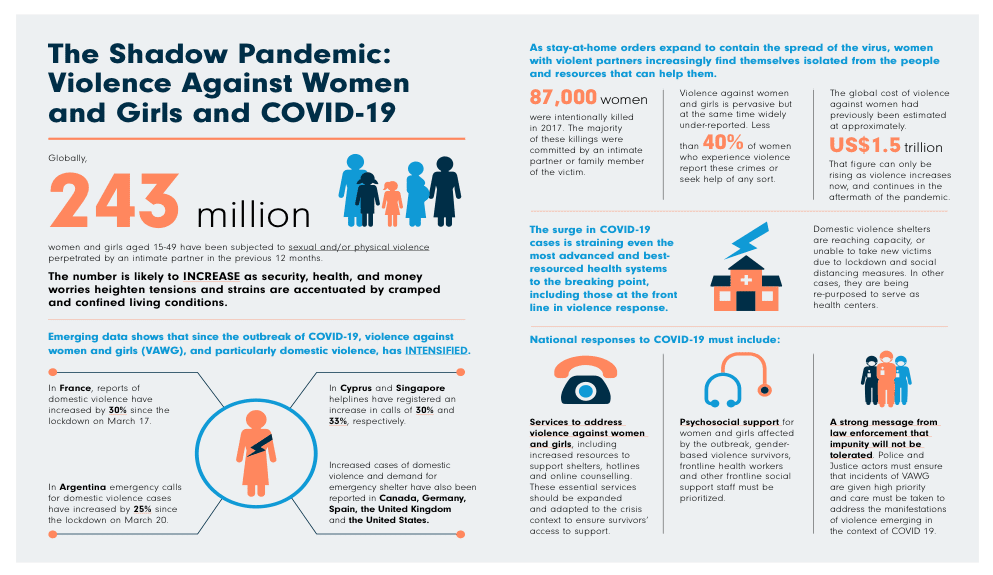Covid-19 and Women
Women across the globe had been looking forward to the year 2020 to celebrate the 25th anniversary of the Beijing Platform of Action – achievements on gender equality and women empowerment. Plans to draw up steps for the coming years were snuffed out by the advent of COVID-19. In fact, the limited gains made in the past decades were rolled back by the pandemic, making the way forward contingent upon the policies and focus of each country in building back.
Economic: According to the UN Policy Brief on the Impact of COVID-19 on Women, women and girls have been affected in every sphere. On the economic front, they earn less, save less and hold insecure jobs, mostly in the informal sector without social security benefits. Women’s employment is at risk at an unprecedented scale, and the consequences could be devastating for women not only in the short term, but also in the long run. Women are losing jobs at a greater speed than men – women’s employment is 19% more at risk than men. They are more likely to lose their source of income and less likely to receive social protection measures.
Health: Though more men have been dying as a result of COVID-19, the health of women generally is adversely impacted through reallocation of resources and priorities. Women and girls have unique health needs, but they are less likely to have access to quality health services, essential medicines and vaccines, maternal and reproductive health care or insurance coverage for routine and emergency health costs, especially in rural and marginalized communities.
Globally, women represent more than 70 percent of those employed in health and social work. Health workers, in particular those dealing with COVID-19 patients are subjected to long working hours, lack of personal protective equipment, understaffed and resource constrained environments, exposure to higher risks of infection and transmission and intense emotional stress. Similarly, 61.8 percent of workers in education are women; they are forced to adapt their work to deploy distance-learning solutions. They are also exposed to a higher risk of contracting the infection, like other “essential workers” in retail, transportation, food and beverage chains.
Unpaid care work: The crisis has also increased care demands on women who remain in employment, even with a slight increase men’s participation in housework and childcare. They are stretched to accompany children learning online, care for older persons and other vulnerable family members.
Poverty: Coronavirus pandemic has impacted the global poverty generally, but women are affected disproportionately. A study commissioned by UN Women and United Nations Development Program (UNDP, points out that, the coronavirus pandemic has brought about a 9.1 percent increase in the poverty rate for women. According to the study, “by 2021, for every 100 men aged 25-34, living in extreme poverty (living on $1.90 a day or less), there will be 118 women and that will increase to 121 women per 100 men by 2030.” Data shows, COVID-19 will push 97 million into extreme poverty by 2021 – 47 million of whom will be women and girls. These numbers reveal the deep flaws of our society and economy.
Gender-based violence: During the pandemic, gender-based violence has increased exponentially due to the economic and social stress coupled with restricted movement and social isolation. Many women were forced to ‘lockdown’ at home with their abusers, while services to support survivors were inaccessible.
Recovery: The talk around recovery is: build back smarter, better, greener and fairer. Given the impact on women and girls, and the role they play in keeping our world ticking, women should be at the heart of the recovery policies and programs. According to UN Women, gender responsive policy making is key to closing the gender poverty gaps. To ensure this, adequate representation of women is needed in COVID-19 response planning and decision making. Since women in the formal economy care jobs – from teachers to nurses are underpaid, transformative changes are required to address the gendered norms of pay. It is crucial to take steps of prevent women from losing their jobs and if not, establish mechanisms for women to re-enter employment as early as possible. Over 100 million women and girls can be lifted out of poverty if governments implement a comprehensive policy strategy aimed at improving access to education, healthcare, equal wages and social transfers.
There is a great need to invest in care – both paid and unpaid. COVID-19 pandemic has made it clear that care services are a pre-requisite for all workers with family responsibilities. Investments in care services have the potential to generate decent jobs, particularly for women (and indirectly for men as well), contributing to women’s integration into the labor market. Investing in gender equality is affordable – while $2 trillion are required to lift the world out of extreme poverty by 2030, only $48 billion are needed to close the gender gap. Governments have to act with urgency, if they fail the numbers will increase. It is important to apply an intentional gender lens to all policies and programs.
Teresa Kotturan SCN
NGO Representative at the UN
Sisters of Charity Federation










0 Comments